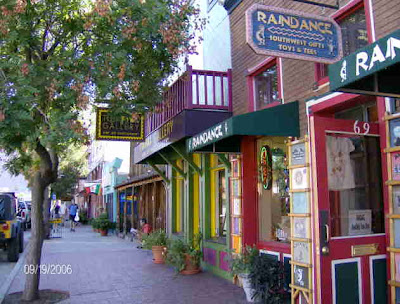
We woke up early. The airport shuttle arrived at about 4:00 am.
For some reason the United counters were packed by 5:00 when we got to BWI and the Sunday 715 am flight was completely full.
Whatever. We got there
Our trip to Colorado and Utah in the summer of 2010 (the dates in the individual post titles are real, the posting times are, well, done to get the pagination right)

 I saw this attraction on the internet. I was looking for something near the airport so we could try the rental car out and see if we liked it.
I saw this attraction on the internet. I was looking for something near the airport so we could try the rental car out and see if we liked it.




 We walked around downtown Georgetown (both images from internet). They had a nice grocery and we had some coffee at the Happy Cooker restaurant (left image). At one time the mayor of Georgetown was the madam of the town brothel so this is a 'evoking' name for a restaurant.
We walked around downtown Georgetown (both images from internet). They had a nice grocery and we had some coffee at the Happy Cooker restaurant (left image). At one time the mayor of Georgetown was the madam of the town brothel so this is a 'evoking' name for a restaurant. 
 I had been to Georgetown before but hadn't taken the scenic Rail Road.
I had been to Georgetown before but hadn't taken the scenic Rail Road.






 After we left Georgetown we drove to Rangely Colorado. This is in the NW part of the State (and a good 250 miles from Georgetown by car).
After we left Georgetown we drove to Rangely Colorado. This is in the NW part of the State (and a good 250 miles from Georgetown by car). 






 We arrived in Moab about 6 pm on the 18th. We checked in at the hotel and went immediately to the Moab Brewery. They brew about 12 different beers there. After some liquid we saw a bit of Moab.
We arrived in Moab about 6 pm on the 18th. We checked in at the hotel and went immediately to the Moab Brewery. They brew about 12 different beers there. After some liquid we saw a bit of Moab.

 The morning of Aug 18 was nice and cool for our visit to the Arches National Monument.
The morning of Aug 18 was nice and cool for our visit to the Arches National Monument.

 The Arches National Park website has a good write up on how the arches are formed.
The Arches National Park website has a good write up on how the arches are formed.



 Iron Horse Hotel (our only 'historic' hotel). The image is from the hotel's website. We had a two story suite facing the railroad (this
Iron Horse Hotel (our only 'historic' hotel). The image is from the hotel's website. We had a two story suite facing the railroad (this  railroad is similar to the one in Georgetown except it is 3 and 1/2 hours in each direction). The hotel had suffered a roof problem from the winter snow and the pool and jacuzzi were closed.
railroad is similar to the one in Georgetown except it is 3 and 1/2 hours in each direction). The hotel had suffered a roof problem from the winter snow and the pool and jacuzzi were closed.



 Early afternoon on the 19th we checked in to our motel in Alamosa and then went out to the Sand Dunes National Park.
Early afternoon on the 19th we checked in to our motel in Alamosa and then went out to the Sand Dunes National Park.
 We hadn't planned to see this but we had some time after the Sand Dunes National Park and it was on the way back to Alamosa so we stopped at a place called "Colorado Gators".
We hadn't planned to see this but we had some time after the Sand Dunes National Park and it was on the way back to Alamosa so we stopped at a place called "Colorado Gators".
 The second image is me holding a live gator. The gator is small and has already been fed but still you have to grip the neck close to the mouth. This is a similar hold to the Alpaca on Aug 15, although the gator in this image is about 1 year old and doesn't nurse so much as bite and swollow.
The second image is me holding a live gator. The gator is small and has already been fed but still you have to grip the neck close to the mouth. This is a similar hold to the Alpaca on Aug 15, although the gator in this image is about 1 year old and doesn't nurse so much as bite and swollow.
 We drove back to Alamosa from the Colorado Gator Ranch, went to the motel and then to the San Luis Brewing Company in downtown Alamosa. The brewery is next door to the District Attorney's Office and near to the county building. In the image is one of their brews, the Hefe Suave (Suave Chief - all their beers are here). This beer had a malt like flavor and was blue-ish and silvery (and unfiltered so you couldn't see through it). Pretty darn good - especially after a big day.
We drove back to Alamosa from the Colorado Gator Ranch, went to the motel and then to the San Luis Brewing Company in downtown Alamosa. The brewery is next door to the District Attorney's Office and near to the county building. In the image is one of their brews, the Hefe Suave (Suave Chief - all their beers are here). This beer had a malt like flavor and was blue-ish and silvery (and unfiltered so you couldn't see through it). Pretty darn good - especially after a big day.